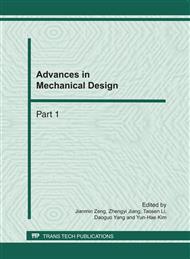p.1074
p.1080
p.1084
p.1088
p.1094
p.1098
p.1102
p.1107
p.1113
Based on Preference Front Wheel Alignment Parameters Robust Design
Abstract:
In order to obtain comprehensive robustness, preference function is applied on front wheel alignment parameter design. Two kinds of uncertainty factors have been integrated into the overall preference function. Random uncertainty is adopted by classical robust design method, and epistemic uncertainty such as individual preference is adopted by range method. The model of front wheel alignment parameters is established applying preference function. The optimal objective is composed of the minimum swing angle of front wheel during wheel bumping, the minimum slider during driving straightly, and the minimum steering angle error during steering. The optimum results are shown robustness on front wheel alignment parameter based on preference function is improved.
Info:
Periodical:
Pages:
1094-1097
Citation:
Online since:
February 2011
Authors:
Keywords:
Price:
Сopyright:
© 2011 Trans Tech Publications Ltd. All Rights Reserved
Share:
Citation:


